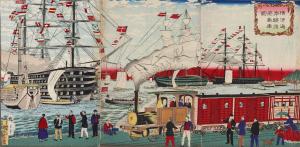Steam Train on the Yokohama Coastal Railway (Yokohama Kaigan Jōkisha Zu)
Painted by Utagawa Hiroshige III circa 1874 (Meiji 7) Tokyo Shiryō Collection 723-C7
This picture shows a newly-introduced steam locomotive as well as steamships from a number of different countries offshore, making it a typical depiction of Yokohama in the early years of Japan's modernization. The car at the far right of the train has the words "intermediate class," showing that different classes of rail travel were already in use at that time.
Yokohama was once a sleepy hamlet, but the opening of a port in 1859 (Ansei 6) occasioned its transformation into Japan's foremost foreign trade city. There emerged a new genre known as yokohama-e (yokohama ukiyo-e), or prints of Yokohama, that depicted the transformation of the port area, steamships, foreign visitors, imported goods, and the like. Most works in this genre were produced in the two years from 1860 (Man'en 1) to 1861 (Bunkyū 1). With the advent of the Meiji period, interest shifted from Yokohama to the new city of Tokyo, and yokohama-e prints began to be replaced by kaika-e, colored woodblock prints of "civilization and enlightenment." A new rail line joining Shinbashi and Yokohama (now Sakuragichō) stations opened in 1872 (Meiji 5), and this became a popular theme for woodblock prints, including many that depicted scenes of Yokohama.


